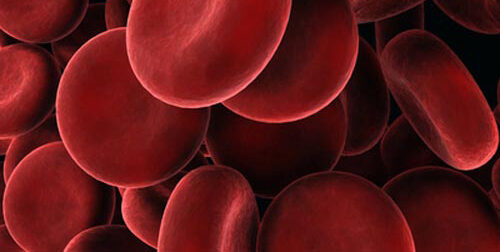The amino acid glutamine plays an unexpected role in erythropoiesis, the differentiation of erythroid progenitor cells into mature red blood cells. Ordinarily, glutamine is broken down by stem cells for various metabolic needs. However, late in differentiation, glutamine is synthesized.
This reversal was uncovered by scientists at St. Jude Children’s Research Hospital, who suggest that red blood cells need glutamine to assimilate and detoxify ammonium, which is a byproduct of heme production. The scientists suggest that if the reversal of glutamine metabolism does not occur, the result may be blood diseases such as β-thalassemia.
Detailed findings appeared in Science, in an article titled, “A glutamine metabolic switch supports erythropoiesis.”
“We discovered a switch from glutamine catabolism to synthesis that is essential for erythropoiesis,” the article’s authors wrote. “We propose that the need to assimilate and detoxify ammonium from heme biosynthesis and other metabolic processes led to the selective activation of glutamine synthesis as a specialized metabolic adaptation for generating erythrocytes.
“In β-thalassemia, oxidative stress causes impaired glutamine synthetase activity and accumulation of glutamate and ammonium, whereas enhancing glutamine synthetase activity alleviates these metabolic and pathological defects. Our findings identify a specialized, evolutionarily conserved metabolic adaptation that could potentially be leveraged to mitigate common red blood cell disorders.”
The authors also suggested that glutamine abundance may serve as a tool for evaluating therapeutic efficacy.
“Mature red blood cells don’t have organelles, such as mitochondria,” said co-corresponding author Jian Xu, PhD, St. Jude Department of Pathology and Center of Excellence for Leukemia Studies. “This raises an important question about how mature red blood cells deal with metabolic needs in order to [be so numerous as to account for 84% of the total cells of a mature adult].”
Xu, along with co-corresponding author Min Ni, PhD, St. Jude Department of Oncology, set out to understand the metabolic processes that regulate normal red blood cell maturation and how this might be altered in various disorders. The research team systematically profiled metabolic changes through each red blood cell maturation stage.
“We found that glutamine metabolism is completely reversed during later differentiation,” Xu remarked. “The cells stop breaking down glutamine and begin to synthesize it.”
Glutamine is broken down as an energy source in early blood cell maturation. However, the researchers found that the enzyme glutamine synthetase flips the script at later stages of development. Heme is the main component of hemoglobin, the protein in red blood cells that carries oxygen. Red blood cell maturation depends on heme production, but ammonium can accumulate if not removed, causing oxidative stress.
The researchers found that red blood cells begin producing glutamine synthetase to facilitate the removal of ammonium by combining glutamate with the ammonium to produce glutamine. “We have genetic and biochemical molecular studies to show that this metabolic process is completely reversed in order to detoxify ammonium that is generated to support heme biosynthesis,” Xu said.
This work impacts the treatment of red blood cell disorders, such as β-thalassemia, because drugs used to treat these disorders are associated with improved red blood cell maturation. However, because glutamine synthetase is found throughout the body, its removal is lethal.
“In our genetic studies, we rarely see patients with glutamine synthetase gene mutations,” Ni explained. “This gene is also critical for embryonic development, so the entire body is affected.”
Through conditional inactivation of the enzyme, the researchers identified a direct link between disruption of glutamine metabolism and red blood cell disorders. “We show this process is impaired in various red blood cell disorders, such as β-thalassemia,” Xu said. “This causes a metabolic phenotype that resembles a glutamine synthetase deficiency, which can be characterized by increased glutamate and ammonia levels and decreased glutamine levels.”
The researchers identified glutamine synthetase oxidation as the source of this deficiency in β-thalassemia. Further, by increasing the protein’s expression, the researchers regained enzyme activity to treat the condition.
Currently, anemia in β-thalassemia can be treated with the drug luspatercept; however, how this drug works is not fully understood. Working with Mitchell Weiss, MD, PhD, St. Jude Department of Hematology Chair and other collaborators, Xu and Ni identified increased glutamine–to–glutamate ratios in studies involving luspatercept, indicating that the drug likely works by recovering glutamine levels.
“This will be the first report to make a connection that the therapeutic benefit of this drug is associated with improved glutamine metabolism,” Xu said.
L-glutamine is also used to alleviate symptoms of sickle cell disease, but how this drug works has similarly been contentious. The findings indicate that the efficacy of L-glutamine supplements likely occurs by fixing glutamine synthetase disruption.
“By supplementing glutamine, you’re providing the red blood cells with additional glutamine for various needs,” Xu explained. “This may explain why L-glutamine is beneficial for sickle cell patients; this is something we are actively studying.”
Beyond its direct impact on treating red blood cell disorders, the findings suggest that metabolic features such as glutamine–to–glutamate ratios can be used as biomarkers for many other diseases.



